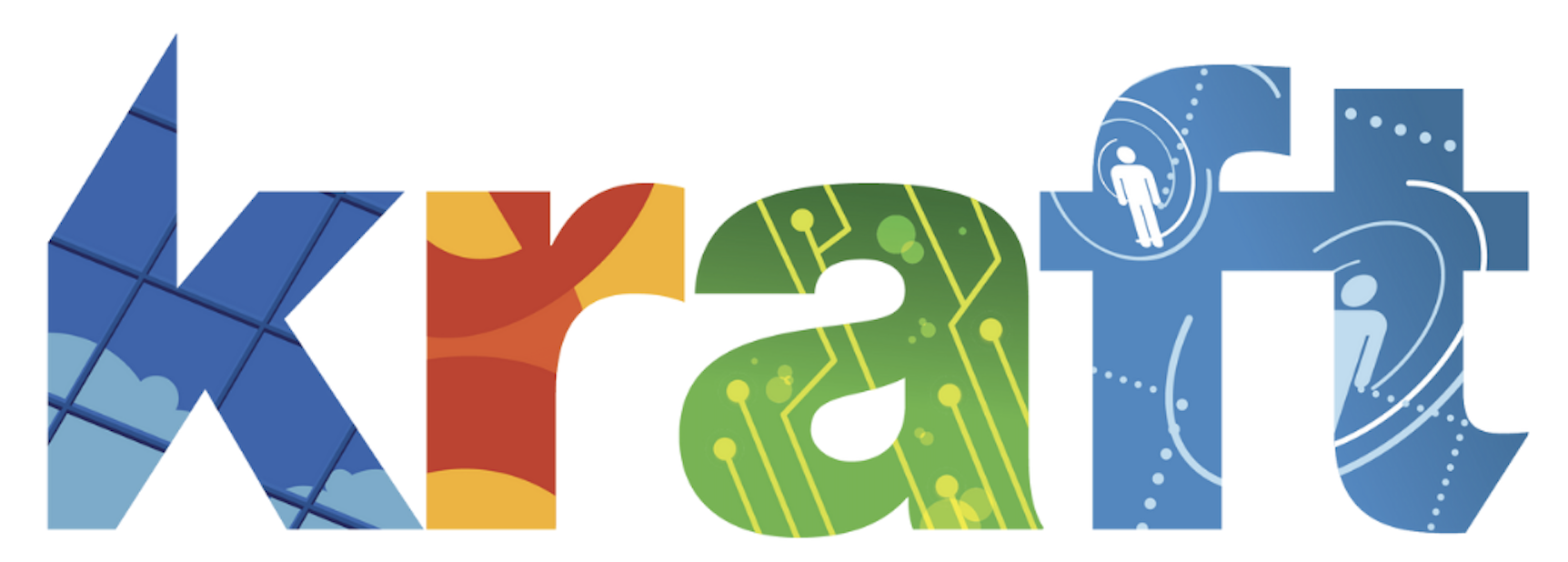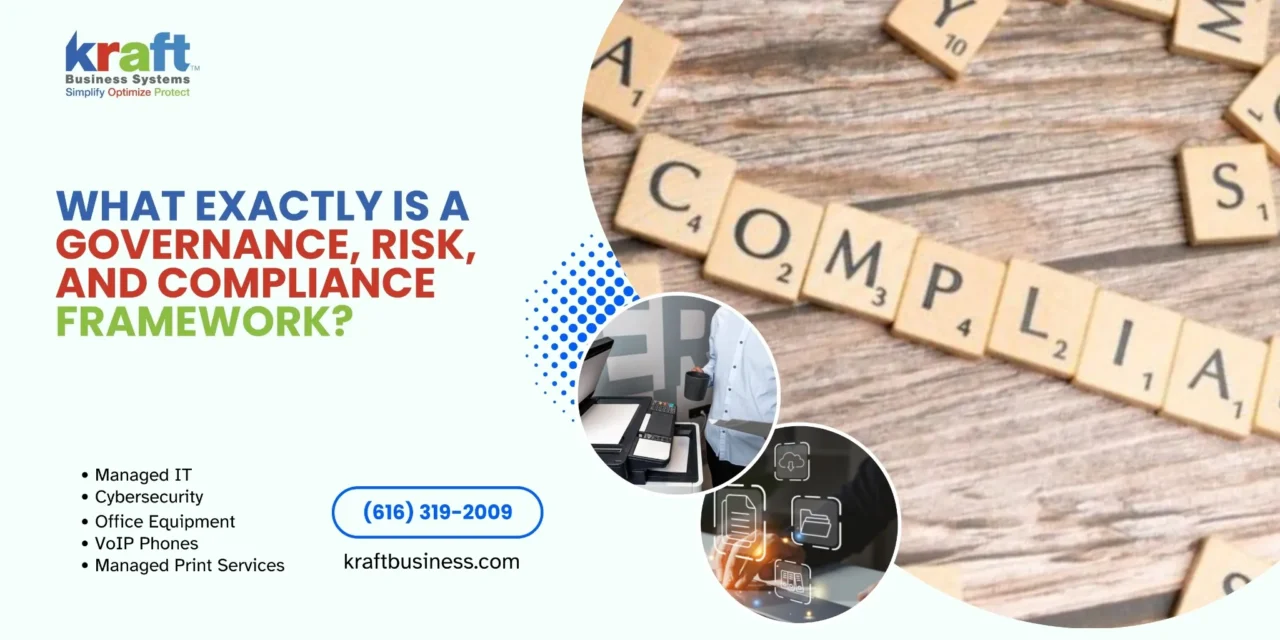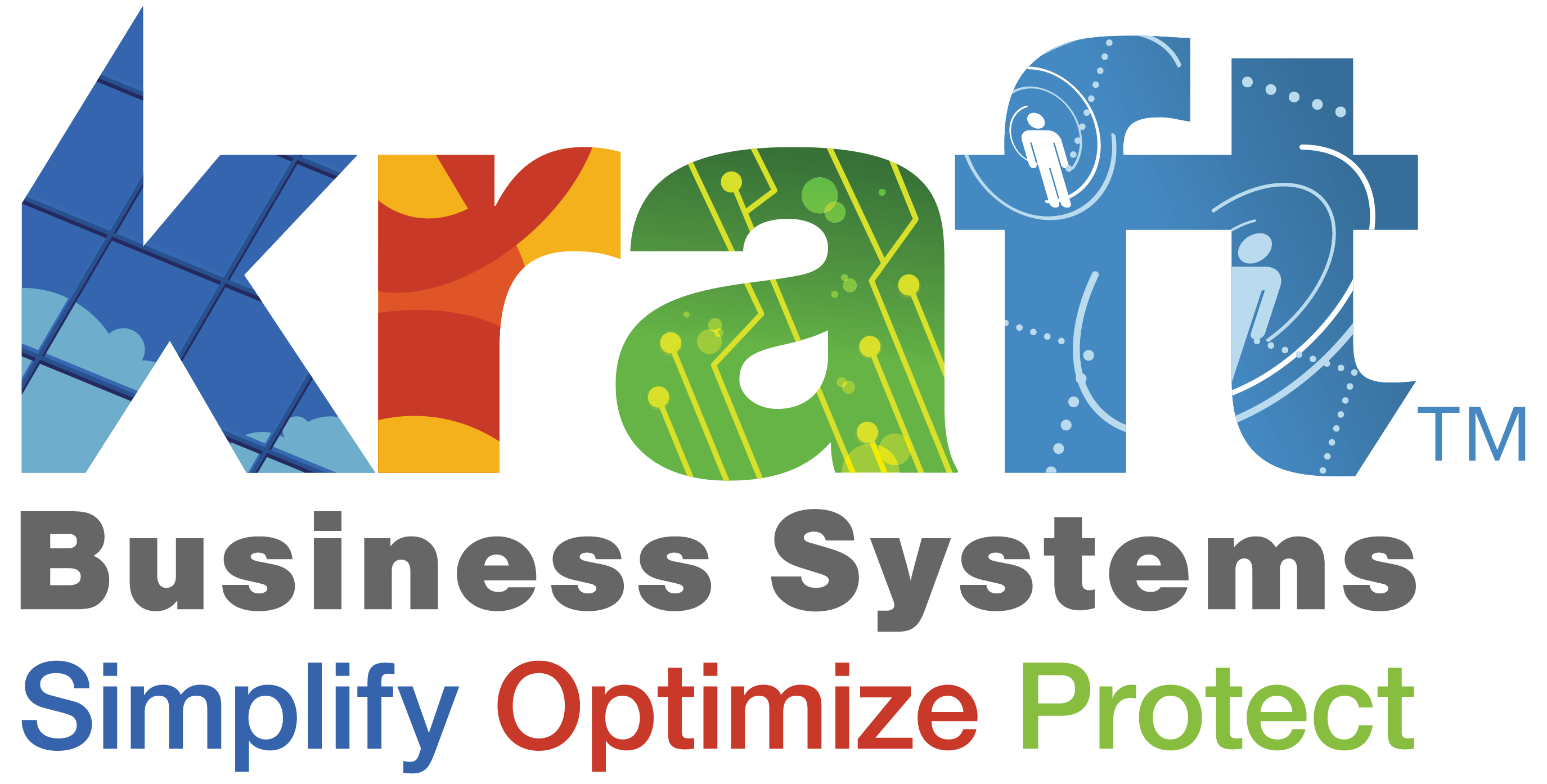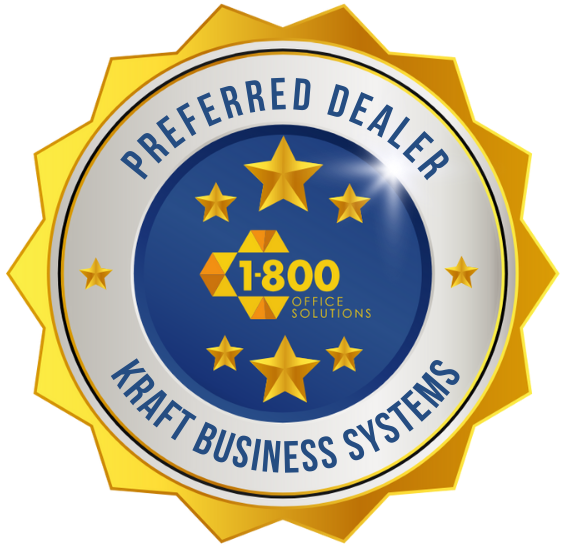A governance risk and compliance framework is an integrated approach that helps organizations align IT with business goals, manage risks effectively, and ensure adherence to regulatory requirements. It provides a structured methodology for maintaining accountability, enhancing decision-making, and promoting ethical conduct across the enterprise.
GRC Framework at a Glance:
| Component | Purpose | Key Elements |
|---|---|---|
| Governance | Establishes oversight and accountability | Board responsibilities, policies, decision-making structures |
| Risk Management | Identifies and mitigates threats | Risk assessment, monitoring, mitigation strategies |
| Compliance | Ensures adherence to regulations | Policy enforcement, regulatory monitoring, reporting |
Organizations face increasing complexity in managing business risks while meeting regulatory demands. Whether it’s cybersecurity threats, data privacy regulations, or operational challenges, a well-structured GRC framework helps businesses steer these obstacles with confidence.
“GRC is not just a box you tick; it’s an engine driving your organization’s decisions,” notes industry experts. This perspective highlights why so many mid-sized businesses are prioritizing GRC implementation – it transforms compliance from a burden into a strategic advantage.
For businesses struggling with outdated systems and security concerns, a GRC framework provides much-needed structure. It breaks down silos between departments, centralizes risk information, and creates clear accountability across all levels of the organization.
According to research from 2025, only 53% of organizations surveyed reported having mature GRC programs, highlighting both the challenge and opportunity in this critical business function.
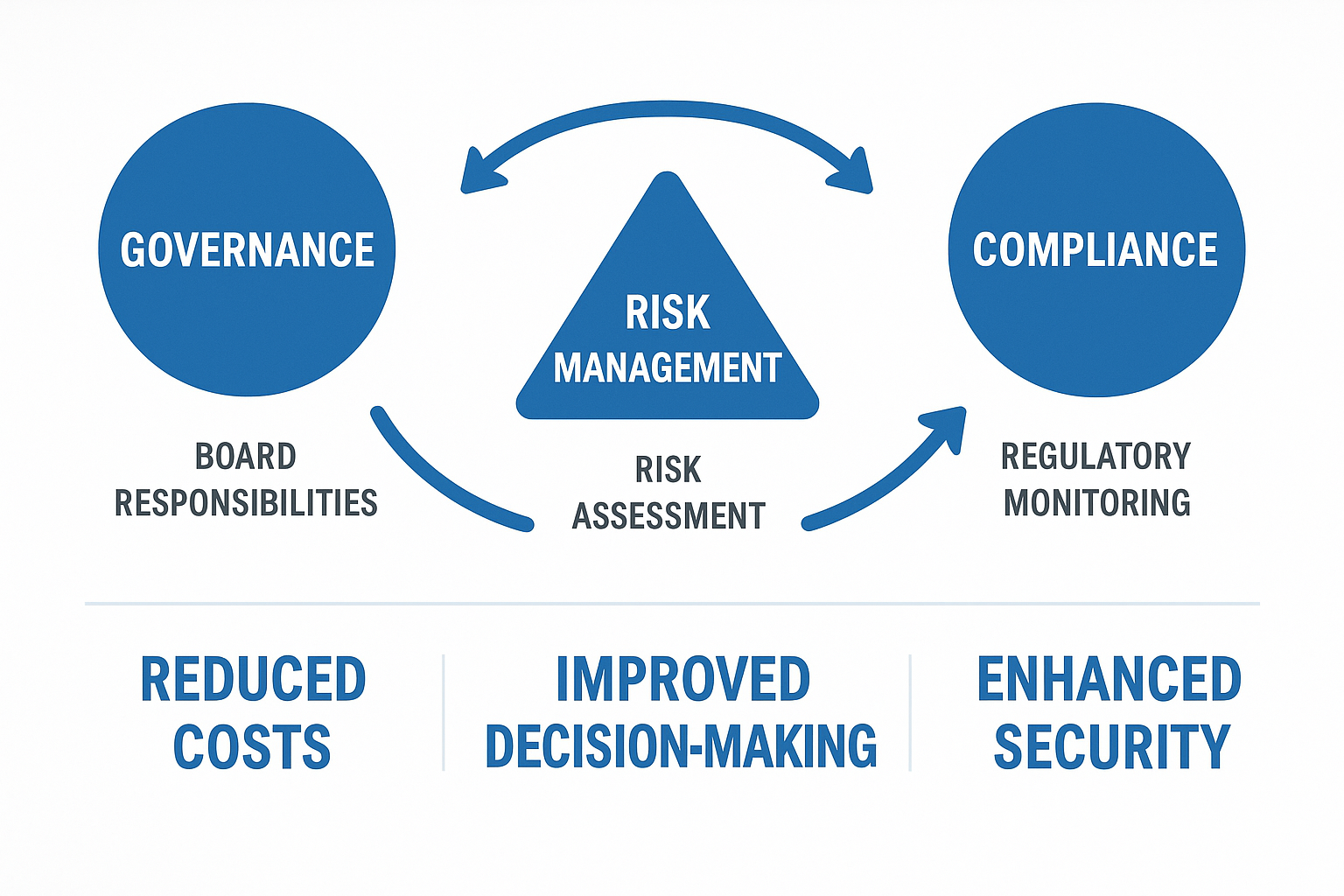
Learn more about governance risk and compliance framework:
Governance, Risk & Compliance Framework Explained
Understanding Governance, Risk, and Compliance (GRC)
The concepts behind GRC have been fundamental to business operations for decades, though the term itself was first popularized in 2007 by the Open Compliance and Ethics Group (OCEG). At its heart, GRC represents a unified set of capabilities that help organizations achieve their goals, handle uncertainty, and operate with integrity.
Let’s explore each of these interconnected elements:
Governance is how an organization steers itself. Think of it as the rulebook and decision-making structure that guides a company’s actions. Good governance ensures everyone from the board to frontline employees knows their roles and responsibilities, keeping the organization aligned with its mission and values.
Risk Management focuses on protecting what matters. It’s the systematic process of identifying potential threats, assessing their likelihood and impact, and developing strategies to handle them. Whether it’s financial uncertainties, operational hiccups, or cybersecurity threats, risk management helps businesses prepare for the unexpected.
Compliance keeps your business on the right side of rules and regulations. It’s about knowing and following both external laws and internal policies. Strong compliance prevents penalties, legal troubles, and reputation damage that can result from violations.
OCEG beautifully ties these elements together in their concept of “Principled Performance” – the ability to reliably achieve objectives, address uncertainty, and act with integrity through the integration of these three critical functions.
What is a Governance, Risk, and Compliance Framework?
A governance risk and compliance framework serves as your organization’s blueprint for coordinating these essential business functions. Rather than treating governance, risk, and compliance as separate departments that rarely communicate, a GRC framework weaves them together into a cohesive system.
This integrated approach creates a living, breathing structure that:
- Establishes clear lines of authority and accountability
- Provides consistent methods for identifying and managing risks
- Ensures regulatory requirements are met efficiently
- Breaks down information silos between departments
A well-designed governance risk and compliance framework isn’t just a dusty document sitting on a shelf. It’s a dynamic system that evolves alongside your organization, adapting to new business challenges, emerging risks, and changing regulations. It transforms what could be burdensome obligations into strategic advantages.
Why is a GRC Framework Important?
For businesses across Michigan and beyond, implementing a robust governance risk and compliance framework has become less of a luxury and more of a necessity. Here’s why:
Risk Mitigation: Think of your GRC framework as an early warning system. By systematically spotting and addressing risks before they become crises, you protect your business from financial losses, operational disruptions, and reputation damage. It’s the difference between being proactive and reactive.
Regulatory Compliance: The regulatory landscape resembles a complex puzzle with constantly changing pieces. A GRC framework helps you fit those pieces together efficiently, ensuring you meet all requirements without excessive duplication of effort or resources.
Strategic Alignment: When governance, risk, and compliance work in harmony, they support your business goals rather than hindering them. This alignment transforms what many view as necessary bureaucracy into a strategic asset that drives growth and innovation.
Ethical Conduct: A strong GRC framework builds integrity into your organization’s DNA. It creates transparency and accountability at all levels, fostering a culture where doing the right thing becomes second nature.
Value Creation: Beyond protection, an effective GRC framework actively creates value by improving decision-making, optimizing resources, and enhancing efficiency across operations.
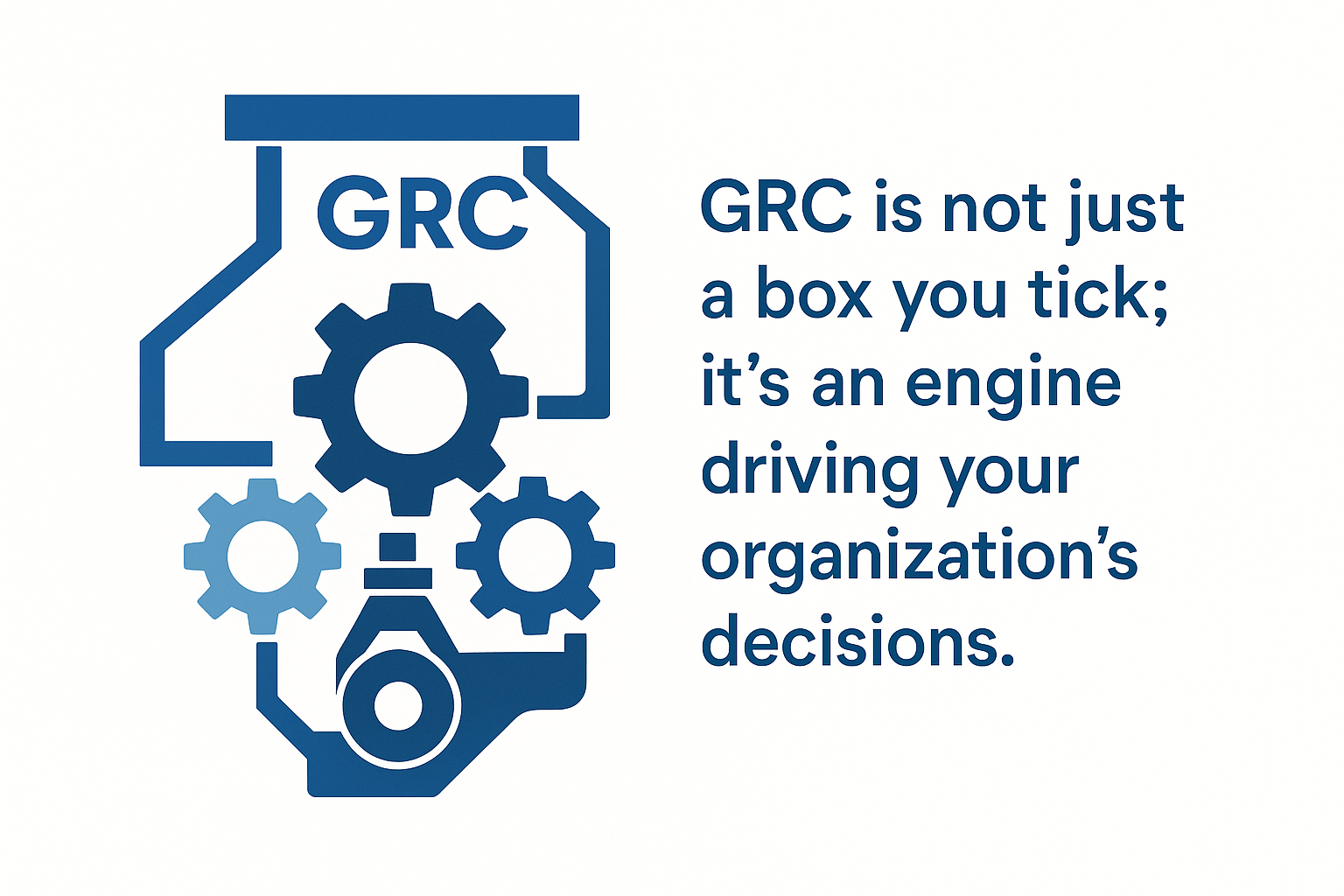
The real impact of GRC becomes clear when we look at cautionary tales. Consider the major bank that collapsed due to poor risk oversight, or the aircraft manufacturer that faced crisis after failing to disclose critical safety information. These weren’t just compliance failures – they were GRC breakdowns with devastating consequences.
When implemented thoughtfully, a governance risk and compliance framework doesn’t just prevent disasters; it becomes a competitive advantage. It allows your organization to move with confidence in uncertain times, knowing you have the structures in place to make sound decisions, manage risks effectively, and maintain the trust of your customers and stakeholders.
Governance, Risk & Compliance Framework Explained
Core Components of a Governance, Risk, and Compliance Framework
A well-designed governance risk and compliance framework isn’t just a collection of policies gathering dust on a shelf. It’s a living system with interconnected parts working together to protect your organization while enabling growth. Think of it as the nervous system of your business—sensing risks, making decisions, and keeping everything running smoothly.
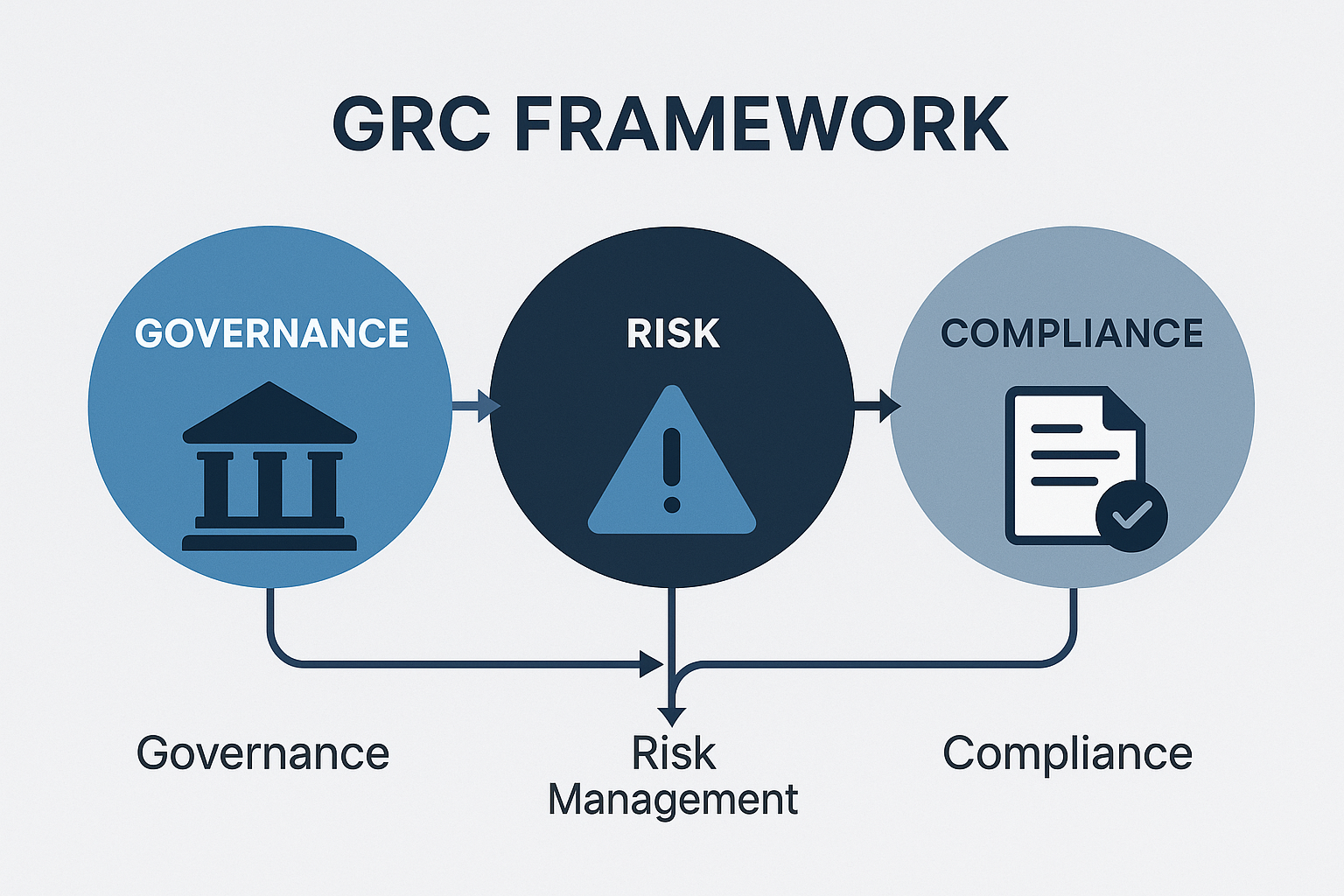
Governance Structures within a GRC Framework
Governance is the backbone of your GRC framework—it sets the rules of the game and determines who makes which decisions.
When we work with Michigan businesses, we often find that strong governance starts at the top. Your board and executive team must clearly define risk appetite and approve key policies. Their attitude toward risk and compliance filters down through the entire organization, creating what we call the “tone at the top.”
Your governance structure needs well-documented policies that guide decision-making without stifling innovation. These shouldn’t be static documents—they should evolve as your business and the regulatory landscape change.
Clear roles and responsibilities eliminate confusion about who handles what. Whether it’s your IT director overseeing cybersecurity risks or your compliance officer monitoring regulatory changes, everyone should know their part in the GRC puzzle.
Effective governance also includes thoughtful decision-making processes. Who can approve exceptions to security policies? At what level are risk acceptance decisions made? Having these processes defined prevents hasty decisions that could expose your business to unnecessary risks.
Lastly, you need ways to measure performance of your GRC activities. Without metrics, you can’t improve what you can’t measure. Regular reporting to leadership ensures accountability and drives continuous improvement.
Risk Management Processes in a GRC Framework
If governance is the backbone, risk management is the brain of your governance risk and compliance framework. It’s how you systematically handle uncertainty.
The risk management journey starts with risk identification—finding the threats that could derail your business objectives. This isn’t a one-time activity but an ongoing process. We’ve seen companies find critical risks during regular brainstorming sessions that might have otherwise gone unnoticed until too late.
Once identified, risks need assessment. Not all risks are created equal. Some might have devastating impacts but are unlikely to occur, while others might be minor but happen frequently. Understanding both impact and likelihood helps you prioritize your response.
For each significant risk, you’ll need to choose a risk response: avoid it completely, transfer it through insurance, mitigate it with controls, or accept it as a cost of doing business. These decisions should align with your organization’s appetite for risk and strategic goals.
Risk monitoring keeps your finger on the pulse of changing conditions. Key risk indicators can provide early warning signs before small issues become major problems.
Regular risk reporting ensures everyone from front-line managers to the board has visibility into the risks that matter to them. We’ve found that visual dashboards work particularly well for making complex risk information digestible.
Our experience shows that organizations with mature risk management processes spot potential problems earlier and respond more effectively, protecting both their reputation and bottom line.
Compliance Management in a GRC Framework
The compliance component of your governance risk and compliance framework ensures you’re playing by the rules—both external regulations and your own internal policies.
Staying on top of regulatory changes is a constant challenge. From HIPAA in healthcare to PCI DSS for payment processing to GDPR for data protection, the regulatory landscape never stands still. Many of our clients dedicate specific resources to monitoring these changes or partner with experts who can keep them informed.
Mapping compliance requirements to your business processes helps ensure nothing falls through the cracks. This mapping shows which regulations apply to which parts of your business and which controls satisfy multiple requirements—a real efficiency booster.
Implementing compliance controls is where the rubber meets the road. These might include technical safeguards like encryption, procedural controls like segregation of duties, or administrative measures like training programs. The best controls often serve multiple purposes, protecting against risks while ensuring compliance.
Regular testing and monitoring verifies that your controls actually work. We’ve seen too many companies assume their controls are effective without checking, only to be surprised during an audit or after a breach.
Compliance reporting gives stakeholders visibility into your compliance status and demonstrates your commitment to meeting obligations. Clear, concise reports that highlight issues and remediation plans build confidence with regulators, partners, and customers alike.
When incidents do occur, having a robust incident management process helps you respond quickly, minimize damage, and learn from the experience. The goal isn’t just to fix the immediate problem but to prevent similar issues in the future.
The sheer volume of compliance work can be daunting—organizations typically maintain more than 200 key internal controls, each requiring significant time to test. This complexity underscores the value of an integrated approach where governance, risk, and compliance work together rather than as separate siloed functions.
By thoughtfully implementing these core components, your governance risk and compliance framework becomes more than just a corporate requirement—it becomes a competitive advantage, helping you steer uncertainties with confidence and integrity.
Governance, Risk & Compliance Framework Explained
Benefits of Implementing a Governance, Risk, and Compliance Framework
When businesses adopt a comprehensive governance risk and compliance framework, they gain much more than just regulatory checkboxes. The benefits reach into every corner of your organization, creating lasting value that goes far beyond basic compliance.
Enhancing Business Performance and Decision-Making
A thoughtfully designed GRC framework acts like a business boostr, improving how you make decisions and run your operations.
With centralized risk and compliance information at your fingertips, your leadership team can make truly data-driven decisions. Instead of guessing or relying on outdated information, you’ll have clear, accurate, and timely insights that help you balance opportunities against potential pitfalls.
Strategic planning becomes more realistic when you understand your risk landscape. Think of it as having a detailed map before starting a journey – you’ll spot potential roadblocks and shortcuts that might otherwise remain hidden. For mid-sized Michigan businesses watching their budgets, this intelligence is particularly valuable.
Resource optimization is another significant advantage. By integrating your GRC activities, you eliminate redundant efforts and use your people more efficiently. We’ve seen this benefit countless times with our clients – when compliance activities are streamlined, team members can focus on growth-oriented work instead of administrative tasks.
The operational efficiency gains can be dramatic. One financial advisory firm we worked with consolidated their risk and compliance functions after a merger, enabling 5,000 users to manage diverse regulatory requirements through a single integrated system. The result wasn’t just better compliance – they saw improved coordination and significantly reduced overhead costs.
Perhaps most importantly, a robust governance risk and compliance framework builds genuine trust with everyone who matters to your business. Customers stay loyal, investors feel confident, and regulators see you as a responsible player. These intangible benefits often translate into very tangible results – customer retention, easier access to capital, and smoother interactions with regulatory bodies.
Managing Cybersecurity Risks with a GRC Framework
When digital threats evolve daily, your governance risk and compliance framework becomes an essential shield for protecting your business.
The structured approach to risk assessment that comes with a GRC framework ensures you’re considering all potential cybersecurity vulnerabilities – not just the obvious ones. This comprehensive view helps prevent the “blind spots” that hackers love to exploit.
Your framework can easily incorporate industry-standard cybersecurity guidelines like NIST, CIS Controls, or ISO 27001. This alignment with recognized standards not only improves your security posture but also demonstrates to clients and partners that you take protection seriously.
Even the best prevention can’t stop every attack, which is why incident response planning is crucial. A good GRC framework includes well-defined processes for responding when security incidents occur. When minutes matter during a breach, having tested response plans ready to activate can make all the difference.
Many businesses overlook third-party risks, but your GRC framework won’t. By establishing vendor due diligence processes, contractual security requirements, and ongoing monitoring, you protect yourself from vulnerabilities that might exist in partner systems.
Cybersecurity isn’t a “set it and forget it” function. Your GRC framework establishes processes for continuous monitoring of emerging threats and regular updates to your security controls. This dynamic approach keeps your defenses current against evolving attack methods.
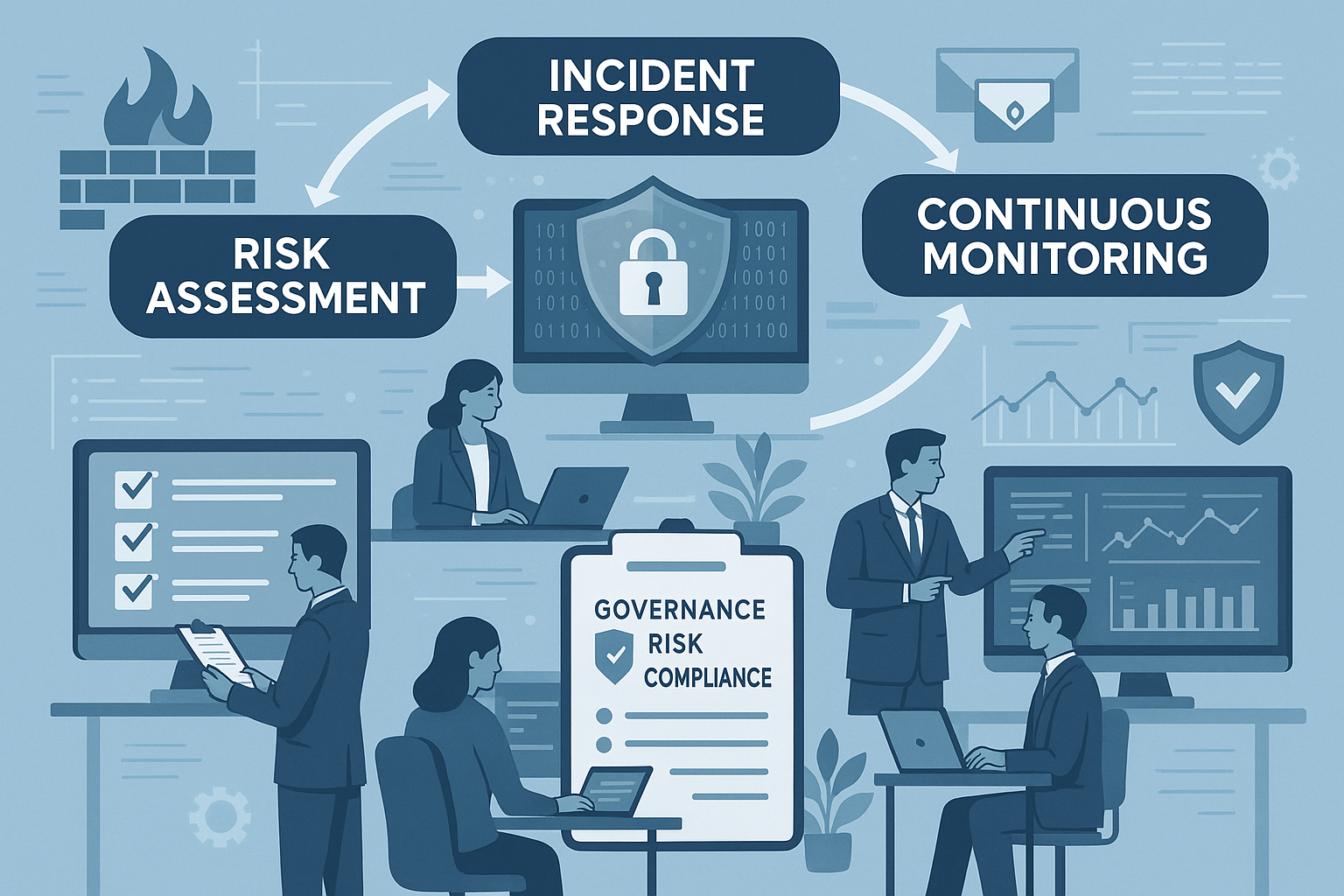
Here at Kraft Business Systems, we’ve helped numerous Michigan organizations transform their cybersecurity approach through effective GRC implementation. A manufacturing client in Grand Rapids reduced their cybersecurity risk exposure by 60% within just six months of implementing our structured GRC approach.
As we note on our GRC Risk Management page, “An effective GRC framework transforms cybersecurity from a technical issue to a business enabler, providing the confidence to pursue digital initiatives without undue risk.”
When your business has a solid governance risk and compliance framework in place, you’re not just protecting what you have – you’re creating the security foundation needed to grow with confidence.
Governance, Risk & Compliance Framework Explained
Challenges in Implementing a GRC Framework
Even with all its benefits, rolling out a governance risk and compliance framework isn’t always smooth sailing. Many Michigan businesses we work with face similar problems when trying to bring their GRC vision to life. Understanding these common roadblocks is half the battle.
Most organizations struggle with breaking down long-standing departmental silos. When finance, IT, legal, and operations have historically operated as separate kingdoms, getting them to collaborate on a unified GRC approach can feel like herding cats.
Resource limitations present another major challenge, especially for mid-sized businesses. As one client told us recently, “We know what we need to do, but we’re stretched thin already.” Finding the budget, staff time, and expertise to implement a robust framework often competes with other pressing business priorities.
Technology integration headaches are nearly universal. Many businesses are working with a patchwork of legacy systems that don’t communicate well with each other. Creating that single source of truth for GRC data can require significant technical work.
And let’s not forget the human factor. People naturally resist change, and new GRC processes often mean new responsibilities, tools, and workflows. Without proper change management, even the best-designed framework can fall flat.
The constantly shifting regulatory landscape doesn’t help either. Just when you think you’ve got everything covered, new requirements emerge. For businesses operating across multiple states or countries, this complexity multiplies exponentially.
Demonstrating ROI for GRC initiatives can be particularly challenging. Unlike sales campaigns with clear metrics, the value of prevented problems doesn’t show up neatly on balance sheets. As one executive put it, “How do you measure the crises that never happened?”
Overcoming Challenges in GRC Implementation
Despite these obstacles, we’ve helped numerous Michigan organizations successfully implement governance risk and compliance frameworks by following proven strategies.
Securing stakeholder buy-in is absolutely critical. Without visible support from leadership, GRC initiatives often stall. We recommend creating a compelling business case that speaks to both risk reduction and business performance improvements. When executives understand how GRC supports their strategic goals, they’re more likely to champion the effort.
Rather than attempting a massive overhaul all at once, starting small and scaling works wonders. One manufacturing client of ours began with a focused GRC pilot in their finance department, demonstrated clear wins, and then expanded to other areas. This approach builds momentum and confidence while managing change at a digestible pace.
Training and change management deserve serious attention. People need to understand not just what’s changing but why it matters to them personally. We’ve seen great success with hands-on workshops, clear communication plans, and identifying GRC champions throughout the organization who can support their colleagues through the transition.
Technology should support your GRC processes, not drive them. Leveraging technology wisely means defining your framework first, then selecting tools that enable your strategy. Too many organizations do this backward and end up forcing their processes to fit limited software capabilities.
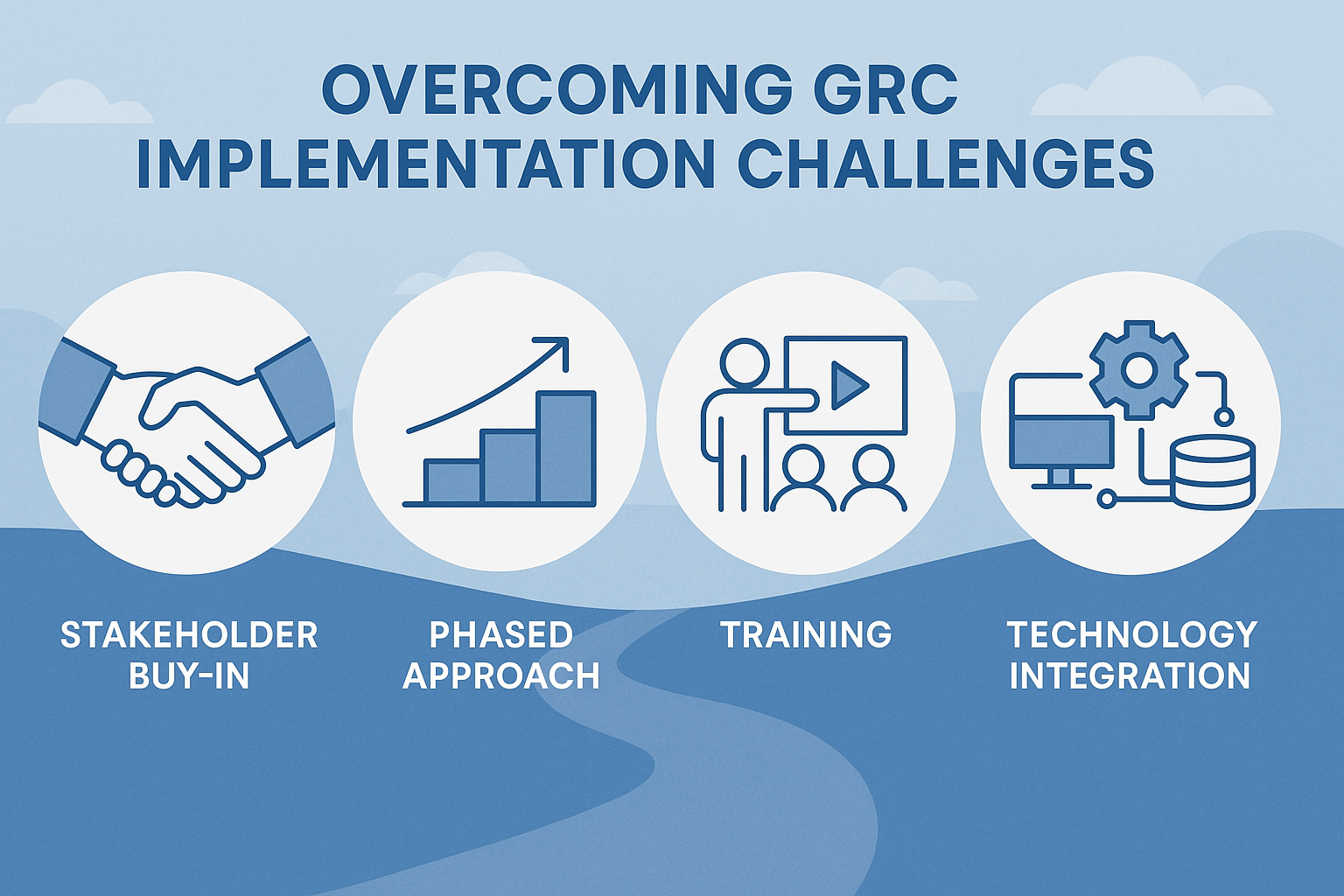
At Kraft Business Systems, we’ve guided businesses across Grand Rapids and beyond through these challenges. Our team works alongside yours to develop practical approaches that fit your specific needs and constraints, rather than imposing cookie-cutter solutions.
Aligning GRC Activities with Business Objectives
The most successful GRC implementations we’ve seen share one key characteristic: they’re tightly aligned with business objectives. When GRC activities feel disconnected from what matters to the business, they’re often seen as bureaucratic obstacles rather than valuable tools.
Creating strategic alignment means ensuring your GRC objectives directly support your organization’s goals. For example, if expanding into new markets is a priority, your GRC framework should help identify and manage the unique risks of those markets while ensuring compliance with relevant regulations.
Clearly defining and communicating your organization’s risk appetite helps teams make consistent decisions. We often help clients develop simple frameworks that clarify what risks are acceptable in pursuit of business goals and which ones cross the line. This prevents the common situation where some departments are overly cautious while others take excessive risks.
Incorporating GRC metrics into performance measurement sends a powerful message about priorities. When leaders are evaluated partly on how well they manage risks and maintain compliance, these considerations become part of everyday decision-making rather than afterthoughts.
Embedding controls within business processes rather than layering them on top improves both efficiency and effectiveness. One healthcare client redesigned their patient intake process to naturally capture compliance information as part of the workflow, reducing staff burden while improving data quality.
Business objectives evolve over time, and your GRC framework must evolve with them. Regular review and adjustment ensures continued alignment as your organization grows and changes. We recommend quarterly check-ins at minimum to assess how well your GRC activities support current business priorities.
A client in the financial services sector transformed their approach by centralizing risk data and standardizing their processes. The result wasn’t just better compliance—they made smarter decisions faster because they had clear visibility into risks across the organization. Their CEO noted that what started as a compliance initiative became a genuine competitive advantage.
Governance, Risk & Compliance Framework Explained
Types of Governance, Risk, and Compliance Frameworks
When you’re looking for the right governance risk and compliance framework for your business, you’ll quickly find there’s no one-size-fits-all solution. Different industries face unique challenges, regulatory requirements, and risk profiles. The good news? You have options that can be custom to your specific needs.
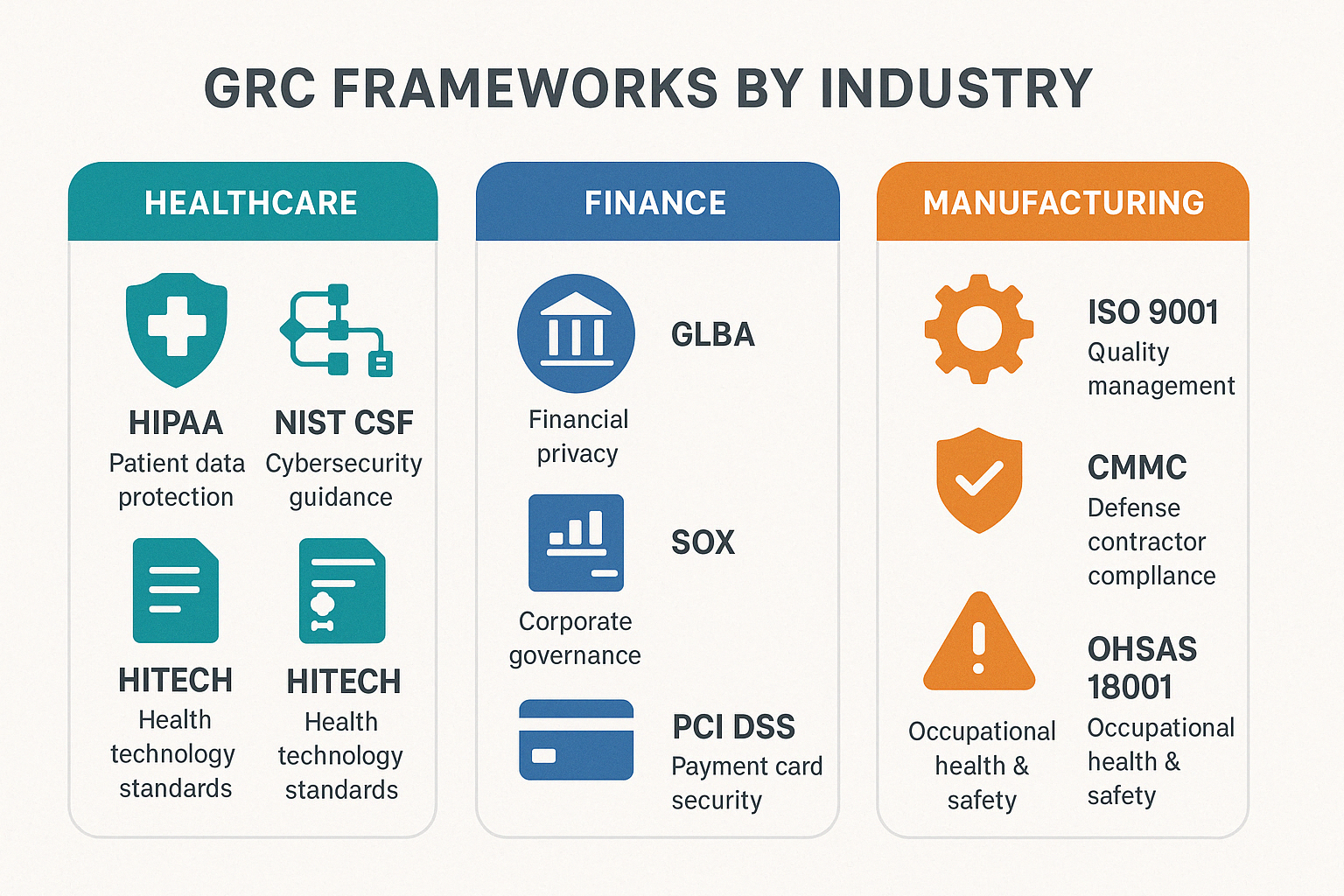
Industry-Specific GRC Frameworks
Different industries have developed specialized frameworks that address their unique challenges and regulatory environments.
If you work in healthcare, you’re probably familiar with HIPAA (Health Insurance Portability and Accountability Act). This framework focuses on protecting sensitive patient information and ensuring privacy. Michigan healthcare providers use HIPAA-based GRC frameworks to safeguard patient data while maintaining efficient operations.
For those in financial services, frameworks like Basel III and Sarbanes-Oxley (SOX) provide structured approaches to financial governance. These frameworks help banks and financial institutions manage financial reporting controls and maintain appropriate capital reserves. They’re particularly important for ensuring transparency and building stakeholder trust.
Retail businesses processing credit card payments need to comply with the Payment Card Industry Data Security Standard (PCI DSS). This framework helps protect cardholder data and secure payment systems. Even small retailers in Grand Rapids and Detroit must follow these standards to avoid penalties and protect customer information.
Manufacturing companies often rely on ISO standards such as ISO 9001 for quality management and ISO 14001 for environmental management. These frameworks help manufacturers maintain consistent quality while meeting environmental responsibilities – increasingly important for Michigan’s manufacturing sector.
Government agencies and contractors typically follow frameworks like FISMA (Federal Information Security Management Act) and NIST Special Publications. These frameworks establish security requirements for federal information systems and help protect sensitive government data.
Many of our Michigan clients start with an industry-specific framework and then customize it to address their particular business needs. This approach provides a solid foundation while allowing flexibility to address unique risks.
Cybersecurity GRC Frameworks
With cyber threats growing more sophisticated by the day, specialized cybersecurity frameworks have become essential components of a comprehensive governance risk and compliance framework.
The NIST Cybersecurity Framework has become one of the most widely adopted approaches. Developed by the National Institute of Standards and Technology, it breaks cybersecurity into five core functions: Identify, Protect, Detect, Respond, and Recover. This practical structure makes it accessible even for smaller businesses without dedicated security teams.
For organizations seeking international recognition of their security practices, ISO/IEC 27001 provides a systematic approach to managing information security. This framework helps you establish, implement, maintain, and continually improve your information security management system. It’s particularly valuable for businesses operating globally.
The CIS Controls offer a more prescriptive approach with specific security actions organized into three implementation groups based on cybersecurity maturity. They’re designed to stop the most common and damaging cyber attacks, making them a great starting point for businesses new to formalized security practices.
For IT-intensive organizations, COBIT (Control Objectives for Information and Related Technologies) provides a comprehensive framework for IT governance and management. It helps align IT initiatives with business goals while managing risks and ensuring compliance.
Defense contractors and businesses working with the Department of Defense should pay special attention to the Cybersecurity Maturity Model Certification (CMMC). This relatively new framework includes five levels of cybersecurity maturity and is becoming a requirement for DoD contracts.
| Framework | Best For | Key Focus Areas |
|---|---|---|
| NIST CSF | General business use | Flexible approach with five core functions |
| ISO 27001 | Global organizations | Systematic information security management |
| CIS Controls | Practical implementation | Specific security actions to prevent common attacks |
| COBIT | IT-intensive organizations | IT governance and business alignment |
| CMMC | Defense contractors | Tiered approach to cybersecurity maturity |
At Kraft Business Systems, we’ve helped numerous Michigan businesses implement these frameworks. For example, we recently worked with a Grand Rapids manufacturing company to implement the NIST Cybersecurity Framework, helping them strengthen their security posture while meeting regulatory requirements for government contracts.
The right framework depends on your industry, size, risk profile, and business objectives. We specialize in helping you steer these options and implement a governance risk and compliance framework that protects your business without creating unnecessary bureaucracy. Learn more about implementation approaches on our GRC Compliance Software page.
Governance, Risk & Compliance Framework Explained
Best Practices for Building and Optimizing a GRC Framework
Building an effective governance risk and compliance framework isn’t something that happens overnight. It requires thoughtful planning, consistent execution, and ongoing refinement. Working with businesses across Michigan has taught us what truly makes GRC implementation successful.
Define Clear Objectives: Start by answering a simple question: “What do we want to achieve?” Whether you’re looking to gain better visibility into risks, streamline compliance activities, or strengthen governance processes, having clear goals will guide every subsequent decision.
Engage Stakeholders Early: The quickest way to doom your GRC efforts is to spring them on people at the last minute. Instead, bring key team members from different departments into the conversation early. When people feel their needs are considered from the beginning, they’re much more likely to support the initiative rather than resist it.
Establish a Common Language: It’s hard to work together when everyone speaks a different language. Create a standard GRC vocabulary that everyone understands. This prevents the confusion that happens when the finance team’s definition of “risk” differs from what the IT department means.
Take a Risk-Based Approach: You can’t address every risk equally – nor should you try. Focus your resources on the most significant threats to your business. This practical approach ensures you get the most value from your GRC investment without spreading yourself too thin.
Integrate with Existing Processes: Nobody wants yet another process to follow. Whenever possible, weave GRC activities into processes people already understand. This makes adoption smoother and reduces the feeling that compliance is “extra work.”
Leverage Technology Appropriately: Good technology can be a tremendous help – but don’t let the tail wag the dog. Select tools that support your objectives and processes, not the other way around. The best technology for your business is the one your team will actually use.
Measure and Report on Performance: What gets measured gets managed. Establish clear metrics to track how well your governance risk and compliance framework is performing, and regularly share these results with stakeholders. This transparency builds confidence and highlights where adjustments might be needed.
Continuously Improve: Your GRC framework should evolve as your business does. Regularly review and update it based on changing business needs, new risks, and lessons learned. The most successful frameworks are living systems, not static documents gathering dust.
Measuring the Maturity of Your GRC Strategy
Understanding how mature your GRC practices are gives you a roadmap for improvement. Several established models can help you assess where you stand and identify your next steps.
The OCEG GRC Capability Model breaks down the components of mature GRC practices and gives you a structured way to evaluate your current state. For those focused specifically on risk management, the Risk Maturity Model helps you gauge your progress from basic, reactive approaches to strategic, integrated practices.
If compliance is your primary concern, the Compliance Program Maturity Model can help you move beyond mere regulatory box-checking toward a compliance program that actively creates business value. For cybersecurity-focused organizations, frameworks like NIST and CMMC include built-in maturity assessments to guide your progress.
Regardless of which model you choose, you’ll typically evaluate factors like:
- How engaged your leadership team is with GRC activities
- The quality and completeness of your policies and processes
- Whether you’ve allocated appropriate resources
- How well you’ve integrated technology
- The effectiveness of your training programs
- Your approach to monitoring and measurement
- Your processes for continuous improvement
At Kraft Business Systems, we help Michigan businesses assess their GRC maturity without judgment or jargon. We understand that every organization starts somewhere, and we’re committed to meeting you where you are and helping you advance at a pace that makes sense for your business.
Leveraging GRC Software and Tools
The right software can transform how you manage your governance risk and compliance framework – turning tedious manual processes into streamlined, automated workflows that free your team to focus on more strategic work.
Policy Management Tools make it easy to create, distribute, and track policies. No more wondering if employees are using outdated procedures or if regulatory changes have been incorporated into your documentation.
Risk Assessment and Management Software gives you a central place to identify and monitor risks. Features like interactive heat maps and dashboards transform complex risk data into visual insights anyone can understand.
Compliance Management Systems help you stay on top of changing regulations by mapping requirements to specific controls within your organization. These tools often include automated workflows for assessments and attestations, reducing the administrative burden of compliance activities.
Audit Management Tools streamline the planning and execution of internal audits. They ensure your audit activities target the right risks and provide consistent documentation that stands up to scrutiny.
Incident Management Systems provide a structured approach to handling governance, risk, or compliance incidents. They help ensure nothing falls through the cracks and that lessons learned become improvements to prevent future issues.
Dashboards and Reporting Tools give stakeholders at all levels visibility into your GRC status. From frontline managers to the board of directors, everyone gets the information they need in a format they can actually use.
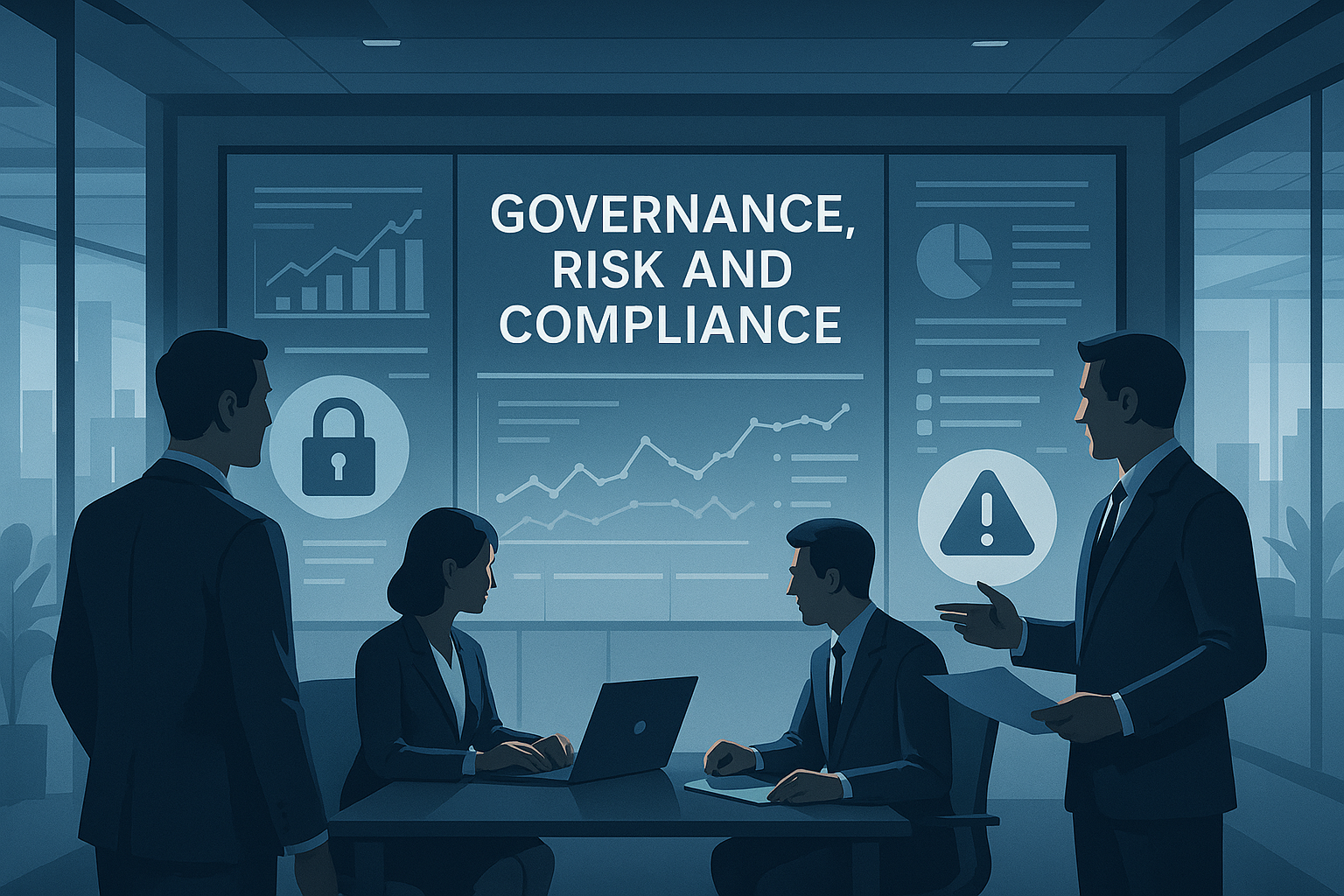
When choosing GRC software for your Michigan business, consider these practical factors:
- Does it align with your specific GRC processes?
- Will it play nicely with your existing systems?
- Can it grow with your business?
- Will your team actually use it, or will it sit on the shelf?
- What’s the true cost, including implementation and ongoing maintenance?
The best GRC software isn’t necessarily the one with the most features—it’s the one that solves your specific problems without creating new ones. At Kraft Business Systems, we help you cut through the marketing hype to find solutions that make sense for your business.
For more insights on selecting the right technology for your needs, visit our Governance Risk and Compliance Platforms page.
Governance, Risk & Compliance Framework Explained
Frequently Asked Questions about Governance, Risk, and Compliance Frameworks
What are the key components of a GRC framework?
When businesses ask us about building a governance risk and compliance framework, they’re often surprised to learn it’s not as complicated as it sounds. The framework consists of three essential building blocks that work together seamlessly:
First, you need solid governance structures that clearly define who’s responsible for what. Think of this as your organization’s backbone – it includes board oversight, well-documented policies, and clearly assigned roles. Without clear governance, even the best risk management efforts can fall flat.
Next comes risk management processes – the systematic ways you identify and handle threats to your business goals. At Kraft Business Systems, we’ve seen Michigan businesses transform their operations by implementing structured risk identification, assessment, and monitoring systems. These processes help you spot potential problems before they become actual headaches.
The third key component is compliance management – the systems that keep you on the right side of laws and regulations. This includes staying on top of regulatory changes, mapping requirements to your business processes, and implementing controls to ensure you’re following the rules.
What makes these components truly effective is how they work together, supported by:
- A shared language everyone in your organization understands
- Technology tools that streamline GRC activities
- Training programs that build awareness throughout your company
- Measurement systems that help you improve continuously
When these elements come together, you create a business environment where good decisions are made, risks are managed thoughtfully, and compliance becomes part of your company culture rather than a burden.
How does a GRC framework improve cybersecurity?
Let me share something we’ve observed while working with businesses across Michigan: organizations with robust governance risk and compliance frameworks are dramatically more resilient against cyber threats.
A good GRC framework improves your cybersecurity in several practical ways:
It brings method to the madness of risk assessment. Rather than reacting to the latest headline-grabbing threat, you systematically identify and prioritize your actual vulnerabilities based on your specific business context.
It creates a comprehensive security blueprint by mapping controls directly to your risks. This means you’re not wasting resources on security measures that don’t address your biggest threats – something especially important for mid-sized businesses with limited IT budgets.
It establishes clear ownership of security responsibilities. We’ve seen too many organizations where cybersecurity falls into a gray area between departments. A GRC framework eliminates this confusion by making it crystal clear who’s responsible for what – from the boardroom to the server room.
It weaves security into your daily operations rather than treating it as a separate technical issue. When cybersecurity considerations become part of regular business decisions, you avoid creating security gaps when launching new products or services.
It keeps you ahead of the curve through continuous monitoring and improvement processes. Cyber threats evolve rapidly, and your defenses need to evolve just as quickly.
It helps you steer the regulatory maze of cybersecurity requirements. From HIPAA to PCI DSS, a GRC framework helps you identify which regulations apply to your business and how to meet them efficiently.
The bottom line? A well-implemented GRC framework transforms cybersecurity from a technical problem into a business advantage – giving you the confidence to pursue digital opportunities without taking unnecessary risks.
What are the common challenges in implementing a GRC framework?
Implementing a governance risk and compliance framework isn’t always smooth sailing. Based on our experience helping Michigan businesses, here are the real-world challenges you might face:
Breaking down departmental walls is often the first hurdle. When risk management lives in one silo, compliance in another, and IT security in yet another, creating a unified approach can feel like herding cats. Each department may have its own language, priorities, and ways of working.
Budget and staffing constraints present another common challenge. Unlike large enterprises with dedicated GRC teams, mid-sized businesses in Grand Rapids and Detroit often need to implement GRC with limited resources and expertise.
Technology headaches frequently arise when trying to connect different systems. You might have financial risk data in one system, compliance information in another, and cybersecurity metrics in a third – getting these systems to talk to each other can be technically challenging.
Resistance to change is almost inevitable. New GRC processes might be perceived as bureaucratic red tape rather than valuable safeguards. As one client told us, “My team already feels overworked – the last thing they want is more paperwork.”
Keeping up with regulations can feel like drinking from a fire hose, especially if you operate in heavily regulated industries or across multiple states. The regulatory landscape keeps shifting, and staying current requires constant vigilance.
Proving the return on investment for GRC initiatives can be tricky. How do you quantify the value of problems that never happened because your framework prevented them?
Data quality issues can undermine even the best-designed framework. If your risk assessments are based on incomplete or inaccurate data, your entire GRC effort might be built on sand.
Finding the right balance between standardization and flexibility is an art. Too rigid, and your framework becomes a straitjacket; too loose, and you lose the benefits of consistency.
At Kraft Business Systems, we’ve helped dozens of Michigan businesses overcome these challenges with practical, right-sized solutions. We believe GRC implementation should be approached as a journey rather than a destination – starting with your most pressing needs and building capabilities over time as your business grows.
Governance, Risk & Compliance Framework Explained
Conclusion
A well-designed and effectively implemented governance risk and compliance framework is no longer a luxury but a necessity for organizations of all sizes. Throughout this article, we’ve seen how these frameworks provide the structure needed to steer complex business challenges while effectively managing risks and meeting regulatory requirements.
The benefits of a comprehensive GRC framework go far beyond simply checking compliance boxes. Organizations that successfully integrate their governance, risk management, and compliance activities experience tangible improvements across their operations:
Better decision-making happens naturally when you have improved visibility into risks. When leaders can see the complete picture, they make more informed choices that balance opportunity with potential downsides.
Operational efficiency increases as redundant processes are eliminated and teams work from a unified approach rather than in silos. This streamlining saves both time and money—resources that can be redirected toward growth initiatives.
Stakeholder confidence grows when your organization demonstrates a clear commitment to ethical conduct. Customers, investors, and partners all value transparency and responsible management.
Resource allocation improves through risk-based prioritization, ensuring your most critical areas receive appropriate attention and investment. This targeted approach provides better protection without unnecessary spending.
Adaptability becomes a competitive advantage as your organization develops the capacity to anticipate and respond to changing conditions before they become crises.
Of course, implementing a GRC framework comes with challenges. Many organizations struggle with departmental silos, limited resources, technology integration problems, and natural resistance to change. Success requires setting clear objectives, engaging stakeholders early and often, selecting appropriate technology tools, and committing to continuous improvement.
At Kraft Business Systems, we understand the unique challenges faced by organizations in Grand Rapids, Detroit, Traverse City, and throughout Michigan. Our team works alongside clients to design and implement GRC frameworks that address their specific needs and constraints.
We believe effective GRC isn’t about implementing complex systems for their own sake. It’s about enabling your organization to pursue its objectives with confidence, knowing risks are properly managed and compliance obligations are met.
For organizations looking to improve their governance, risk management, and compliance capabilities, we offer services ranging from initial assessment and strategy development to implementation support and ongoing optimization. Our Managed Cybersecurity Services include GRC solutions custom specifically for mid-sized businesses.
The path toward a mature governance risk and compliance framework doesn’t have to be overwhelming. With the right approach and support, you can implement effective GRC practices that protect what you’ve built, improve performance, and support sustainable growth.
Ready to take the next step in your GRC journey? Contact Kraft Business Systems today to learn how we can help you build a governance, risk, and compliance framework that meets your unique needs and delivers lasting value.
